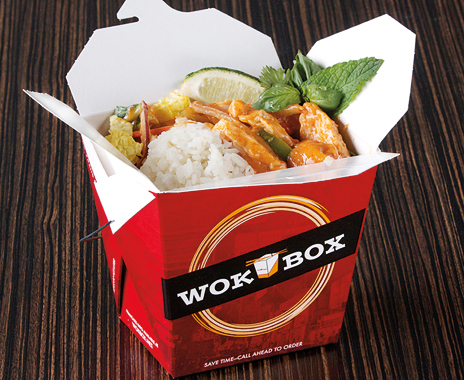Wok Box Fresh Asian Kitchen is bringing the cuisine of 10 different countries—Thailand, Malaysia, Mongolia, Singapore, Korea, China, Japan, India, Cambodia, and Vietnam—to a growing number of U.S. regions.
Wok Box first opened in Edmonton, Alberta, slightly more than a decade ago. The concept expanded throughout Canada before entering the U.S. in 2012. There are seven Wok Box stores open in the U.S.—in Phoenix, Dallas, and Orlando—and plans are to add 15 more stores in 2015, in those markets as well as Denver, Chicago, and Detroit.
“We’re trying to partner with good franchisees,” says Wok Box CEO Lawrence Eade. “We can handle opening 15–25 in 2015 and another 20–30 the year after that. We should be at 50 stores in the U.S. in the next three years. That will give us a solid foundation, and we can grow quickly to a couple hundred by 2020.”
A typical Wok Box location is around 1,500 square feet in size, with an open kitchen and 45–50 seats.
“No one else is doing the small-footprint, high-quality Asian restaurant in the U.S.,” Eade says. He says other fast-casual Asian concepts are larger but have less menu diversity. Another difference Eade cites between his brand and other Asian brands is that all Wok Box stir-fries are made to order.
The Wok Box menu is divided into four main categories: stir-fry rice boxes, noodle boxes, curry boxes, and Naan-Wich sandwiches. Several ingredient options are listed within each category. Naan-Wich choices include Butter Chicken, Thai Beef & Basil, and Teriyaki Chicken.
“The Naan-Wich does well at lunch because it’s handheld for the grab-and-go customer,” Eade says.
Butter Chicken, an Indian recipe made with a spicy curry sauce, is also available in a rice box, as is Mongolian Beef & Broccoli and Breaded Crispy Chicken. Curry boxes are available with chicken, marinated steak, or tofu, along with a choice of veggies. Noodle box choices include chicken, marinated steak, shrimp, and tofu. After choosing a protein, guests can customize their noodle box with ingredient combinations that include Singapore Cashew, Sweet Mongolian, Korean Firecracker, and Kung Pao, all made using various sauces and ingredient additions. The Firecracker Noodle Box, for example, includes bacon, kimchi, nori (seaweed), and a spicy sauce.
Wok Box Fresh Asian Kitchen
CEO: Lawrence Eade
HQ: Vancouver, British Columbia
Year Started: 2004
Annual Sales: $30 million
Total Units: 58
Franchise Units: 57
In addition to the four main entrée categories, Wok Box offers Vietnamese Beef Pho soup and small bites like spring rolls and traditional Indian samosas filled with curried spiced potatoes, peas, and carrots.
Wok Box promotes healthy eating, and many menu items can be made vegetarian, vegan, or wheat-free, Eade says. “Dishes can be customized to meet the health needs of our guests, or they can be a treat for people who just want to go out and have something to treat themselves,” he says.
Butter chicken is one of those “treat” options. Its sauce is made from fresh tomatoes, tomato paste, butter, cream, milk, and spices. Eade says when Wok Box enters a new market, the butter chicken dishes are not top sellers at first, but as people get a taste of it, sales creep up until it is the No. 1 protein.
Other best sellers include the Singapore Cashew noodle box with sriracha peanut sauce, fresh vegetables, broccoli, cashews, and cilantro. The Mongolian Beef & Broccoli rice box with sweet garlic sauce, grilled marinated steak, and broccoli is also a top seller.
To educate customers about butter chicken and other offerings they might not be familiar with, Eade says, Wok Box menuboards are very descriptive and staff is trained to greet customers, explain menu items, and offer samples.
“If people have a deer-in-the-headlights look in front of the menuboard, we help walk them through it,” he says. “Once you start doing that, you can find something anyone will like. We appeal to a varied demographic—young people Instagramming their food and seniors who are used to mom and pop Chinese restaurants. We appeal to people who are looking for quality and variety when they look for food, not people whose only purpose is filling themselves up.”
An average ticket at a U.S. Wok Box location is about $12. The lunch/dinner split depends on the market. In downtown urban centers, lunch sales are higher, while suburban locations attract a larger dinner crowd. On average, Eade says, about 60–70 percent of Wok Box sales occur during dinner hours.
“At lunch we’re competing with quick-serve restaurants, but at dinner we’re competing with sit-downs,” Eade says.
In order to compete with higher-end establishments for the dinner crowd, Wok Box offers wine and local beers. “It’s a nice value for people who want to go out for dinner,” Eade says. “You can have beer or wine and feel like you’re in a nice restaurant.”
Carryout is also a large component of business, accounting for at least 50 percent of sales. “Our restaurants have open-concept kitchens with the wok stations,” Eade says. “People can see their food being cooked and packaged up so they know it’s fresh.”












